Each year, on August 2, Susana Rivera makes her way to the hilltop village of Los Angeles, Nosara, Guanacaste. This year, like years prior, Susana along with hundreds of Nosarenos make the pilgrimage to the top of San Juan Mountain to show respect to La Virgen de Los Angeles (the Virgin of the Angels), patroness of Costa Rica.
The eight kilometer uphill trek begins in early morning’s contemplative darkness. At 4 a.m. the path is a quiet one but for the sounds of the jungle. The thickness of the forest enveloping the narrow, red dirt road slows the dawn. Darkness fades; the morning sun illuminates the moisture in the air, pushing through the forest and over the hill crests in energetic bursts and as light takes over it becomes evident that Susana is not alone.
Small groups of men, women and children spot the winding road from Nosara town to Los Angeles. Many walk, some travel horseback, others by motor vehicle and a few are strong enough to bike up the steep pitches. No matter the means, all head in the same direction with a similar purpose.
It is not an easy journey; paramedics can be found camped out at different places along the road. From time to time the sirens of the Red Cross ambulance can be heard.
“It is not supposed to be easy, or fun, this is about sacrifice. If it were not for the virgin I would not do this, but it is important to me to show my respect and demonstrate my love for Mary, “said a cheerful yet tiring Susana. “In this case it is the horse that makes the sacrifice” she jokes kindly, pointing at a saddle-seated passerby.
Nearly 300 kilometers east a similar pilgrimage takes place. On less of an incline, hundreds of thousands walk the 25 kilometers from San Jose to Cartago and gather at the Nuestra Senora de Los Angeles Basilica.
|
|
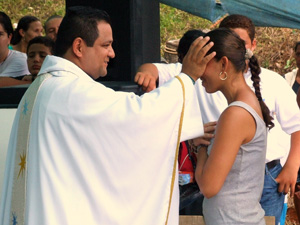
Susana receives a blessing from Padre Juan Perez
|
| |
|
| |
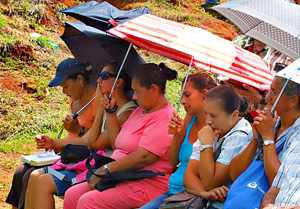
Women shade themselves during the mass |
| |
|
| |
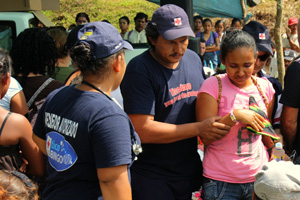
The heat and emotion becomes too much for this young women,
paramedics rush to remove her from the congregation |
It was in Cartago that the tradition began. In August of 1636, in the woods outside of the city, a young woman was collecting wood when she came across a stone image of the Virgin Mary, with a baby Jesus in arms. From source to source the story varies, however, in each account it is said that the stone image miraculously appeared in the place it was originally found in after being removed several times. The stone came to be known as La Negrita because of its dark coloring. In 1824 the government of Costa Rica declared Virgin de Los Angeles to be the country’s patron saint. Since this time the traditional honoring of the Virgin Mary on the second day of August has become a national holiday. Eventually, in 1912 the basilica was erected near the place where La Negrita was found.
Two hours after beginning her journey, Susanna reaches her destination. She is greeted by a clear sky, and an intense morning sun. A merciful breeze kisses the top of the mountain and each of the travelers, grateful of its embrace.
The destination, a small, humble, white washed chapel nestled between a brand new elementary school and a large soccer pitch sits with its hand carved wooden doors wide open. It is still quiet on the hilltop. About 100 people are scattered about, greeting each other warmly, smiling and catching up.
A calm hum of cheerful banter can be heard everywhere but for the church; in the peace of the morning the church is silent. Here, Susanna, joined by a few others , takes a moment to kneel before a small, dark stone image of the Virgin Mary, holding her Son, a replica of La Negrita. A dozen candles flicker and reflect off the teal, tiled floor in front of the carving.
The simple act of kneeling on the hard floor, covered in gritty sand, after hours of walking uphill is another sacrifice Susana and others are not hesitant to make. Pain is visible in the faces of those who kneel as they stiffly rise to their feet.
After some quiet prayer, it is time to eat. Between the soccer field and the church vendors are selling traditional foods cooked over an open wood fire. The air is filled with mingling scents of spices and smoke. Visitors pay a small fee for their freshly cooked meals, coffee and other refreshments, buying extra to take home. The money made from the sales of food each year on the second of August is a significant monetary infusion for the community of Los Angeles, one of the county’s most impoverished villages. |
|
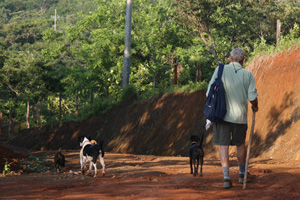 This man makes the pilgrimage to the top of the hill with five canine This man makes the pilgrimage to the top of the hill with five canine
companions
|
| |
|
| |
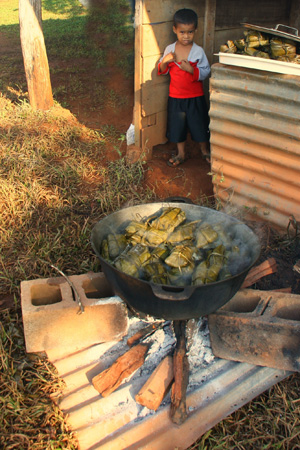
All hands on deck for the preparation of typical food for the day's
celebrations |
| |
|
| |
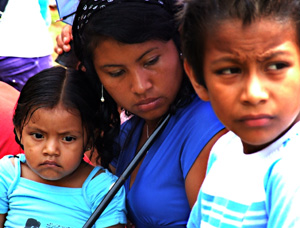
A mother and her two children shade themselves from the hot sun
while listening attentively to the serman |
Between six and nine a.m. the gathered eat and share friendly greetings. During this time more and more people arrive. The calm hum grows into a jubilant buzz. Finally the ceremony begins with opening prayers in the church. From the church, a procession to the soccer field led by Padre Juan Jose Juarez Perez, and participants carrying on their shoulders an intricate gold adorned Mary and child.
The ceremony, including introductory prayers, a procession around the soccer pitch and a full mass takes up the better part of four hours. Perez says the objective of the day’s mass is to teach the wisdom that can be found in the bible, specifically, the importance of serving others out of love rather than out of personal interest.
Despite the harshness of the afternoon sun and ever shortening attention spans Padre Perez, known to his parishioners as Juan-Jo, never loses the attentive focus of his audience. Even when brief technical difficulties prevent his microphone from carrying his - simultaneously severe and warm - voice, his audience remains captive.
It is evident, this man is loved. His service is interactive, his congregation involved. Circling him rather than sitting beneath him in front, he makes the members of the congregation listen, think, cry and laugh. People young and old clamor to take his picture when the service wraps up.
The missionary priest who arrived in Costa Rica in 2008 from Mexico has brought with him a great deal of change. Not only to the celebration of the Virgen De Los Angeles, but to the community of Catholics in the area. Of the most tangible changes is the discontinuation of alcohol sales at the religious event.
“This is a religious celebration, an act of faith, it should not be mixed with alcohol ingestion because it distracts from the real meaning,” said Perez. “Alcohol harms men, it brutalizes them.” Without the sale of alcohol the celebration has changed bringing more families and fewer tourists to the mountain. |
|
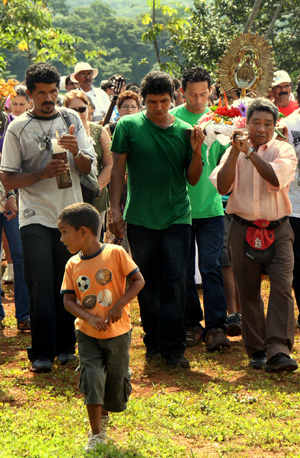
The final segment of the procession around the soccerfield, it
is the men's turn to carry the virgin statue on theirshoulders |
Celebrations and festivities followed the ceremony. Students from a local high school put on a short theatrical production which had its audience roaring. Children gathered eagerly around a piñata, hung from a soccer net and the adults took part in traditional games.
As dark clouds rolled in and the sound of distant thunder could be heard it was time for Susana to begin the second half of her trek back down the mountain.
 |
| |
More Regional News
Police Continue Investigation of the Poisoning Death of a High School Student
A bizarre and saddening incident has shocked the community of Nosara. Tuesday August 23, 17 year old Hernandez was intercepted by two men on his way to school. The victim explain to the judicial police that a man allegedly assaulted him with a gun, forced him to drink poison and then robbed him of 50 000 colones and his cell phone.
Man in Samara attacks mayor over property dispute
As Mayor Marcos Jimenez was visiting Samara on Tuesday, August 23, Manfred Spitzbarth struck him twice with a club, according to witness Oscar Aquilino Baltodano, first in the stomach and then in the arm. He also hit another municipal official in the shoulder, Collection Agent Steven Alfaro Arnáez, collection agent, who then took the club away from him.
Proper Road Maintenance Too Costly for Nosara
Road maintenance between Samara and Ostional is at a standstill. The National Roads Authority (Conavi) is responsible for ongoing maintenance to Route 160 between the two villages but is facing a question of quality versus financial and legal obsticles.
Busy Week for Samara Police
One man stabbed in front of police station and two detained for fighting at a bar
The Samara Police (Fuerza Publica) dealt with two incidents of aggression last week. As a result two men were detained and another man is, in effect, banished; he is restricted from coming within one kilometer of Samara.
Lightning Strikes Killing American Woman
Thirty six year old, Jenifer Faith King, of Los Angeles, California was pronounced dead after being hit by lightning. The accident occurred in Ostional Beach, 11 kilometers from Nosara town, between three and four p.m. Thursday August 11.
Samara Police Proud Owners of Patrol Vehicle
Patrolling Samara and the surrounding communities just got easier for the public force with the addition of a valuable new resource: a pickup-style truck fitted with a topper to detain and transport suspects.
Domestic Violence
Trying to Break the Cycle
Woman discusses her ongoing battle with spousal abuse
They had been married about 6 months the first time it happened. He came home drunk and she asked him for the money she had earned at her job. They started fighting and he knocked her down the stairs of the two-story house they lived in. She tried to defend herself with a broom, but he cut the broom into pieces and cut her, leaving a permanent scar along her neck.
Nicoya Takes Step to Begin the Process of Closing Garbage Dump
Various people from Nicoya and Samara know that the colonial city's garbage dump collapsed 12 years ago. Efforts to solve the "stinky" problem didn't work and the Ministry of Health has closed the dump twice. However, it appears that this time the Municipality of Nicoya is looking for a final solution. The Municipality decided to begin the technical closure to diminish the environmental impact, and to create a recycling center to reduce the quantity of refuse that is sent to the dump.
Association Will Seek Concession Over the Nosara River
The Nosara Development Association wants material from the Nosara River to benefit the community and expects that the Ministerio de Ambiente, Energía y Telecomunicaciones (Energy and Telecomunicatin Minister), through the Dirección de Geología y Minas (Geology and Mines Department), will take them into consideration, granting them a concession to exploit the river's materials. |
 |
|
|

